This is named after the heroic wireless operator on the ill-fated Titanic. At the rear of the pub is the Phillips Memorial Cloister. Many of those who survived the Titanic said that Jack Phillips had saved their life. Jack’s birthday, on 11 April, is celebrated with a drink in the pub which now bears his name.
Prints and text about The Jack Phillips.
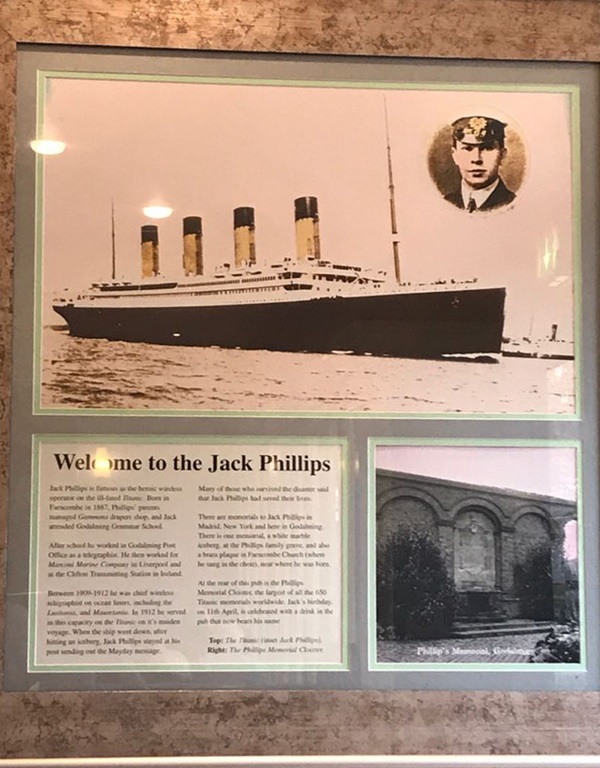
The text reads: Jack Phillips is famous as the heroic wireless operator on the ill-fated Titanic. Born in Farncombe in 1887, Phillips’ parents managed Gammons draper’s shop, and jack attended Godalming Grammar School.
After school he worked in Godalming post office as a telegraphist. He then worked for Marconi Marine Company in Liverpool at the Clifton Transmitting Station in Ireland.
Between 1909-12 he was chief wireless telegraphist on ocean liners, including the Lusitania and Mauretania. In 1912 he served in this capacity on the Titanic on its maiden voyage. When the ship went down, after hitting and iceberg, Jack Phillips stayed at his post sending out the Mayday message.
Many of those who survived the disaster said that Jack Phillips had saved their lives.
There are memorials to Jack Phillips in Madrid, New York and here in Godalming. There is one memorial, a white marble iceberg, at the Phillips’ family grave, and also a brass plaque in Farncombe Church (where he sang in the choir), near where he was born.
At the rear of this pub is the Phillips Memorial Cloister, the largest of all the 650 Titanic memorials worldwide. Jack’s birthday, on 11 April, is celebrated with a drink in the pub that now bears his name.
Top: The Titanic (inset Jack Phillips)
Right: The Phillips Memorial Cloister.
A print of Jack Phillips.
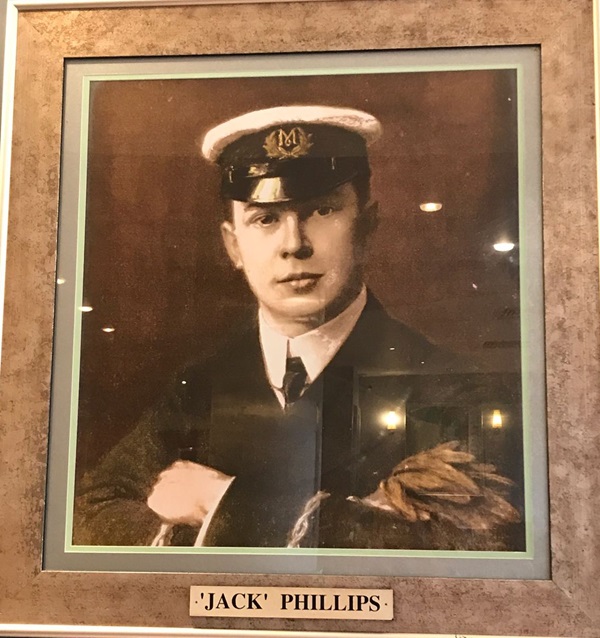
Prints and text about this history of Godalming.
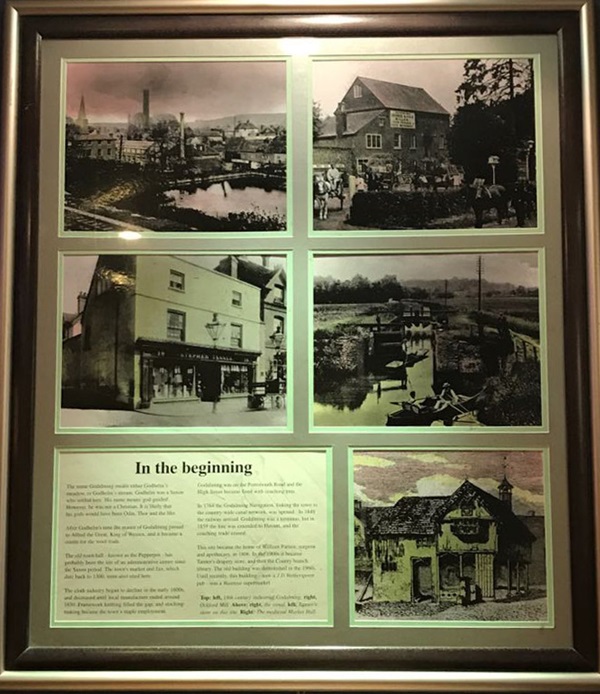
The text reads: The name Godalming means either Godhelm’s meadow, or Godhelm’s stream. Godhelm was a Saxon who settled here. His name means ‘god-guided’, however, he was not a Christian. It is likely that his gods would have been Odin, Thor and the like.
After Godhelm’s time in the manor of Godalming passed to Alfred the Great, King of Wessex, and it became a centre for wool trade.
The old Town Hall – known as the Pepperpot – has probably been on the site of an administrative centre since the Saxon period. The town’s market and fair, which date back to 1300, were also sited here.
The cloth industry began to decline in the early 1600s, and decreased until local manufacture ended around 1850. Framework knitting filled the gap, and stocking-making became the town’s staple employment.
Godalming was on the Portsmouth Road and the High Street became lined with coaching inns.
In 1764 the Godalming Navigation, linking to town to the country-wide canal network, was opened. In 1849 the railway arrived. Godalming was a terminus but in 1859 the line was extended to Havant, and the coaching trade ceased.
This site became the home of William Parson, surgeon and apothecary, in 1806. In the 1900s it became Tanner’s drapery store, and then the county branch library. The old building was demolished in the 1960s. Until recently, this building – now a J D Wetherspoon pub – was a Waitrose supermarket.
Top: left, 19th century industrial Godalming, right, Ockford Mill
Above: right, the canal, left, Tanner’s store on this site
Right: The medieval Market Hall.
Prints and text about the Charterhouse School.
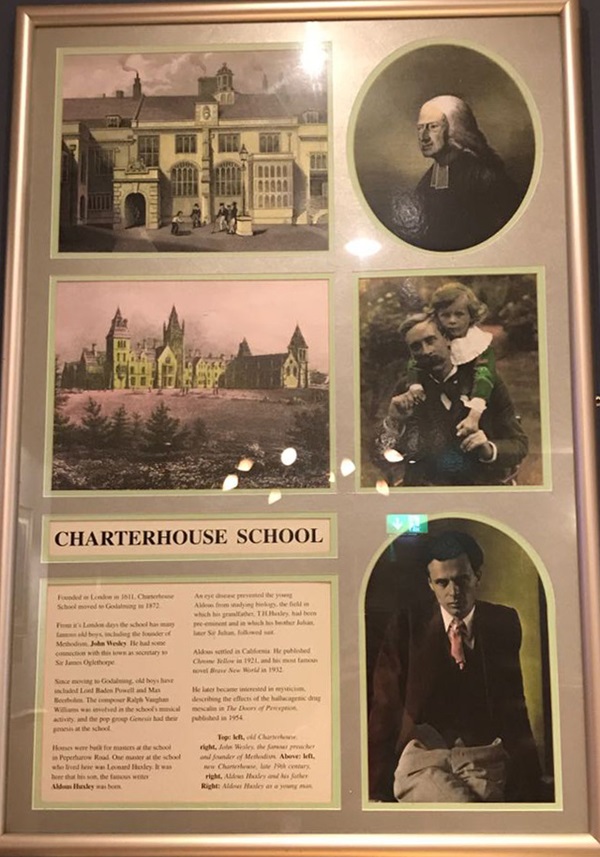
The text reads: Founded in London in 1611, Charterhouse School moved to Godalming in 1872.
From its London days the school has many famous old boys, including the founder of Methodism, John Wesley. He had some connection with this town as secretary to Sir James Oglethorpe.
Since moving to Godalming, old boys have included Lord Baden Powell and Max Beerbohm. The composer Ralph Vaughan Williams was involved in the school’s musical activity, and the pop group Genesis had their genesis at the school.
Houses were built for masters at the school in Peperharow Road. One master at the school who lived there was Leonard Huxley. It was here that his son, the famous writer Aldous Huxley was born.
An eye disease prevented the young Aldous from studying biology, the field in which his grandfather, TH Huxley, had been pre-eminent and in which his brother Julian, later Sir Julian, followed suit.
Aldous settled in California. He published Chrome Yellow in 1921, and his most famous novel Brave New World in 1932.
He later became interested in mysticism, describing the effects of the hallucinogenic drug mescaline in The Doors of Perception, published in 1954.
Top: left, old Charterhouse, right, John Wesley, the famous preacher and founder of Methodism
Above: left, new Charterhouse, late 19th century, right, Aldous Huxley and his father
Right: Aldous Huxley as a young man.
Prints and facts about the history of Godalming and its people.
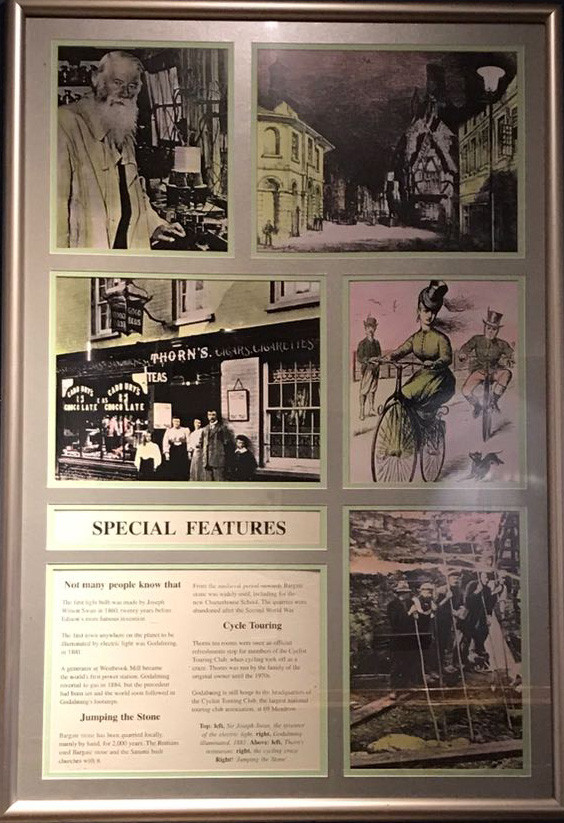
The text reads: The first light bulb was made by Joseph Wilson Swan in 1860, twenty years before Edison’s more famous invention.
The first town anywhere on the planet to be illuminated by electric light was Godalming, in 1881.
A generator at Westbrook Mill became the world’s first power station. Godalming reverted to gas in 1884, but the precedent had been set and the world soon followed in Godalming’s footsteps.
Bargate stone has been quarried locally, mainly by hand, for 2,000 years. The Romans used Bargate stone and the Saxons built churches with it.
From the medieval period onwards, Bargate stone was widely used, including for the new Charterhouse School. The quarries were abandoned after the Second World War.
Thorn’s tea rooms were once an official refreshments stop for members of the Cyclist Touring Club, when cycling took off as a craze. Thorn’s was run by the family of the original owner until the 1970s.
Godalming is still home to the headquarters of the Cyclist Touring Club, the largest national touring club association.
Top: left, Sir Joseph Swan, the inventor of the electric light, right, Godalming illuminated in 1881
Above: left, Thorn’s restaurant, right, the cycling craze
Right: ‘Jumping the Stone’.
Prints and text about famous locals.
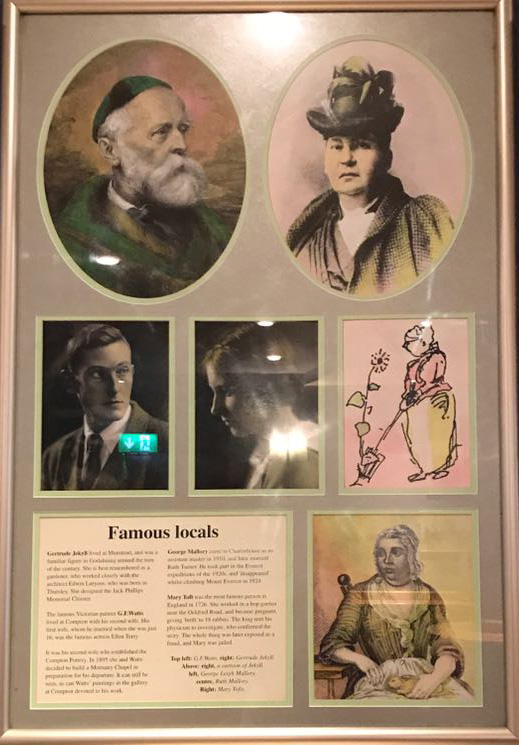
The text reads: Gertrude Jekyll lived at Munstead, and was a familiar figure in Godalming around the turn of the century. She is best remembered as a gardener, who worked closely with the architect Edwin Lutyens, who was born in Thursley. She designed the Jack Phillips Memorial Cloister.
The famous Victorian painter GF Watts lived at Compton with his second wife. His first wife, whom he married when she was just 16, was the famous actress Ellen Terry.
It was his second wife who established the Compton Pottery. In 1895 she and Watts decided to build a mortuary chapel in preparation for his departure. It can still be seen, as can Watts’ paintings in the gallery at Compton devoted to his work.
George Mallory came to Charterhouse as an assistant master in 1910, and later married Ruth Turner. He took part in the Everest expeditions of the 1920s, and disappeared whilst climbing Mount Everest 1924.
Mary Toft was the most famous person in England in 1726. She worked in a hop garden near the Ockford Road, and became pregnant, giving ‘birth’ to 18 rabbits. The King sent his physician to investigate, who confirmed the story. The whole thing was later explained as a fraud, and Mary was jailed.
Top left: GF Watts, right, Gertrude Jekyll
Above: right, a cartoon of Jekyll, left, George Leigh Mallory, centre, Ruth Mallory
Right: Mary Tofts.
External photograph of the building – main entrance.
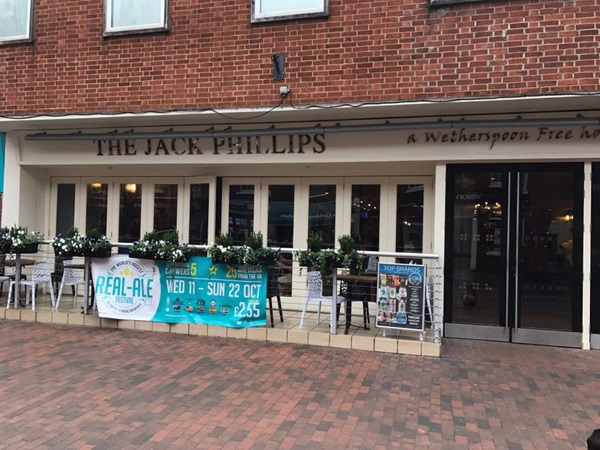
If you have information on the history of this pub, then we’d like you to share it with us. Please e-mail all information to: pubhistories@jdwetherspoon.co.uk